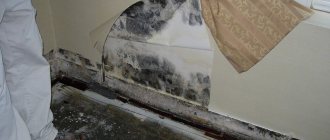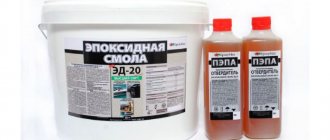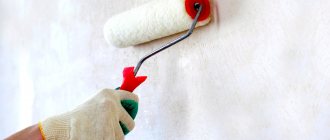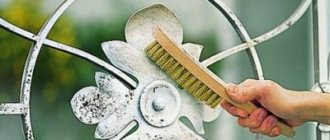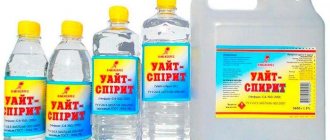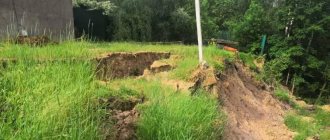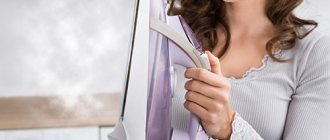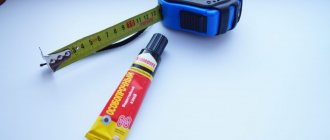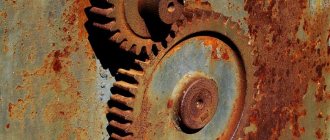Mold is a microscopic fungus that is harmful to the surface on which it appears and to the health of the occupants of the home. As a result of the spread of microorganisms, the appearance of the room deteriorates. Dark stains can spread to carpets, furniture and other interior items.
Today there are many means to combat mold on walls. We reflected the best of them in a rating based on customer reviews. We recommend using the presented drugs together with mechanical methods of elimination. It will be useful to install a device for better air exchange, seal voids in the walls and ensure sufficient ventilation in the room.
Rules for chemical processing
When choosing a control method, it is important to remember that any of the listed remedies in their pure form can harm human health.
Therefore, before work you need to protect yourself: put gloves on your hands, cover your face with a respirator or mask. The rules for using the drug are described in detail by the manufacturer in the instructions. It is important to follow them during application. The technical data sheet of the composition indicates the dosage that can destroy the fungus. You cannot experiment with changing it.
Personal protective equipment for treating walls with antiseptic compounds Source lkmprom.ru
Usually, before work, the product is diluted with water and then applied to the affected area. To work, you may need a construction trowel, a stiff brush, a roller or a sprayer. Before applying the drug, the area must be cleared: remove the coating. The fungus first affects the upper layers; it spreads especially quickly inside walls covered with plaster. It penetrates through it and forms a branched mycelium. Therefore, first you need to completely remove the coating material with a spatula, and only then begin to “poison” the fungus. Typically, you leave the mold remover on the walls until it dries.
How to remove fungus-affected trim from wallsSource cleanadvice.ru
If the problem is not resolved the first time, you will have to re-process it. After the base has dried thoroughly, it must be coated with an antiseptic primer and re-plastered with cement mortar, after which the surface should be covered with a waterproofing compound. Then it will be possible to prevent the occurrence of “relapses”. The right anti-mold paint on the walls will look good. Its layer will protect against moisture penetration and will not allow fungal spores to penetrate deep into the finish again.
When wallpaper pasted on a concrete base is affected, you need to remove it completely, carefully remove the black deposits with a spatula, and only then treat the area with antiseptics. It is best to use deep penetration formulations for this. They are absorbed into the porous structure of concrete, kill the fungus and stop its spread. You can begin cosmetic repairs only when the antiseptic has completely dried.
Wallpaper with mold growing under it must be removed Source www.propertydamageconsultants.com
Mold-infected plasterboard sheathing will also have to be completely dismantled and thrown outside
It is important to carefully inspect the sheathing after dismantling. The absence of traces of its damage does not allow one to refuse preventive disinfection
This is more relevant when the sheathing is assembled from wood. If you thoroughly saturate all the planks with wood preservative, you can reinstall the drywall.
What happens if mold is not removed?
Black spots on the walls are not only an aesthetic problem. They are a threat to human health. The fungus develops quickly. It reproduces through spores, and during this process they are scattered throughout the house. Each of us, by inhaling mold spores, runs the risk of experiencing a deterioration in health. Such microorganisms can provoke the development of complex diseases of the respiratory system, including bronchial asthma.
Mold is dangerous to humansSource www.kras-ref.ru
If you leave the fungus and do nothing about it, over time it will completely destroy the affected surface and damage building structures. There is no point in postponing such an event. As soon as a characteristic musty smell appears in the room, you need to start looking for the first traces of damage. Now, knowing how to remove mold, it will be much easier to fight it.
When antifungal treatment is carried out: conditions
Due to the great danger of the development of fungal colonies in the premises, treatment is carried out immediately:
- If visible signs of damage are detected - the appearance of plaque, mucus, and blackening of the surface.
- After eliminating emergency situations involving water flooding or sewerage breaks.
- When there is a systematic deterioration in the well-being of people in the room.
Preventive treatment is carried out:
- During the renovation of the premises.
- During general cleaning.
- Before and after the end of the heating season.
To increase the effect of using fungicides and disinfectants against mold, it is recommended to additionally treat the walls of the bathroom and toilet at least once a week.
Video description
The video shows one of the options on how to 100% get rid of mold in the house:
https://youtube.com/watch?v=lQlq35bpWRA
Briefly about the main thing
Any remedy for mold and mildew on walls works the same way: one penetrates the structure of the material, kills the pathogenic microorganism and prevents the damage from spreading further. There are a large number of chemical preparations and solutions that can be prepared from vinegar, chlorine, and hydrogen peroxide. Their use can eliminate the problem of the appearance of unattractive black spots, but without eliminating the causes of their occurrence, the fight will be pointless. The fungus will appear again and again, posing a threat to human health.
Abedis 06
It is used outside and inside buildings, in free-standing outdoor gazebos, in greenhouses, on garden paths made of a variety of materials. The drug is considered a multifunctional antiseptic. Produced in the form of an emulsion. Recommended as a prophylactic against fungal microorganisms and mold. Successfully removes existing organic plaque. Abedis is recommended for use in construction as an additive to paints and solutions. We are allowed to work in institutions for children. The drug is based on guanidine, which is considered one of the most powerful antiseptics, and water as a solvent.
Before starting work, the product is diluted with water in a ratio of 1:2 and the walls are treated completely, regardless of the degree of fungal damage. Then leave it to dry for a day and wash off with water. After drying, repeat after 2.5 days if necessary. Work is carried out in protective equipment. The drug is stored after opening for 36 months. Consumers report in reviews about the long-term effect of the antiseptic.
Primer consumption per 1 m2
The quality, characteristics and types of materials for processing affect what the material consumption will be. An important role is played by the temperature and humidity that remain in the room. The rate increases if the mold primer requires at least two coats rather than one.
Consumption rates are indicated by the manufacturer on the packaging. But experts recommend multiplying standard odds by at least 1.5. Then it will be easier to anticipate some situations.
Most universal compounds are suitable for working with concrete surfaces. Manufacturers provide recommendations regarding places of use and operating conditions. You need to familiarize yourself with them before purchasing, only in this case the anti-fungal composition will be effective.
Most universal compounds are suitable for working with concrete surfaces.
When using any primer, be sure to follow safety precautions and protect yourself. Instructions and work tips are also read before the project begins to be implemented. Everyone needs a respirator and safety glasses. The primer itself is stored in places where children cannot reach it. You should not immediately follow the advice about buying compounds with a reserve. It will not be difficult to purchase additional materials. But it is difficult to use the excess - there is a high probability that the expiration date will expire earlier. This also prevents unnecessary spending.
Keratolytics
This group of drugs in the rating can be represented by different drugs: varnishes, patches, solutions, creams. Their peculiarity is that the effect is to soften the structure of the nail, due to which its rejection is not so difficult. The basis of keratolytic agents are acids: benzoic, lactic, salicylic. The composition also includes bactericidal compounds, for example, bifonazole or ketoconazole. Among these medications are:
Nailitis. The main component is urea, and additional components are beeswax, tea tree oil and mineral oil. Release form: 15 g sachets with a special emulsion. The advantage of the drug is that it helps to quickly get rid of the affected nail plate
The downside is that the product cannot come into contact with the skin, so you need to use it very carefully. Nogtimycin. The composition of the cream includes urea, corn oil, salicylic acid
The product makes the plate soft. Plus, after just a few procedures, the nail can be easily removed. Disadvantage - there is no data on the presence of a systemic effect on the human body.
What pills to take for fungus
The choice of medicines for fungus is made exclusively by a doctor, who takes into account the clinical picture of the disease and the general health of the woman or man. Unauthorized termination of therapy or replacement of antifungal drugs in broad-spectrum tablets with other medications is prohibited. Below is a rating of effective antifungal agents for the treatment of different types of mycoses.
Antifungal drugs for body skin
Dermatomycosis is a frequently diagnosed disease that affects the skin of the head, legs, arms, abdomen, and other parts of the body. There are many antifungal drugs aimed at eliminating skin mycosis, among them the best are:
- Nystatin. The medication is used to treat not only skin fungus, but also candidiasis of the vagina, mouth, and intestines. The drug is taken 3-4 times a day, 1 tablet. The doctor selects the dosage for the child individually.
- Fluconazole. Prescribed for candidiasis of various organs, including the skin. The second generation antimycotic has a negative effect on the liver, but after completion of treatment the organ is restored. The recommended daily dosage is 150 mg weekly (taken 2-3 times in total). Find out more about how to take fluconazole.
- Itraconazole Capsules are prescribed for the treatment of skin mycoses, candidiasis, and onychomycosis. The drug is suitable for the prevention of the listed pathologies in people with HIV. The recommended daily amount of a broad-spectrum agent is 200 mg (the course lasts a week).
- Clotrimazole. Can be used for the treatment of fungus, lichen, trichomoniasis. These inexpensive but effective tablets are taken as prescribed by a doctor, who individually selects the dosage. The course of treatment is at least a week.
- Ketoconazole. Tablets are widely used for the treatment of seborrheic dermatitis and dermatomycosis. The product is contraindicated during pregnancy and breastfeeding. The doctor prescribes Ketoconazole at a dosage of 200 mg per day, determining the duration of administration individually for each patient.
Tablets for candidiasis
Having diagnosed a mild degree of thrush, the doctor prescribes topical tablets. For the treatment of acute forms of candidiasis, it is necessary to take a wide range of drugs. Treatment lasts on average 2 weeks. As a rule, a gynecologist prescribes one of the following remedies for the treatment of thrush:
- Pimafucin. Due to its mild action, the drug can be used even during pregnancy and breastfeeding. Pimafucin does not provoke allergic reactions and is well tolerated. Thrush tablets contain natamycin and are non-toxic.
- Clotrimazole. Effective for the treatment of vaginal candidiasis, but not suitable for oral use during pregnancy or breastfeeding.
- Diflucan. As a rule, a single dose of an antifungal drug is enough to treat thrush. Contraindications for Duflocan: pregnancy, lactation, chronic kidney and liver pathologies.
Antimycotics for nail fungus
The initial stage of development of onychomycosis is successfully treated with local means: solutions, ointments, special varnishes, gels. If the disease has affected a large part of the nail plate, you cannot do without broad-spectrum tablets. The doctor selects the appropriate medication based on the degree of the disease. The most effective antifungal drugs for toenails are:
- Fluconazole (price – 25-50 rubles);
- Ketoconazole or Nizoral (about 500 rubles);
- Itraconazole (RUR 2,500);
- Flucostat (about 200 rubles);
- Terbinafine (up to 2000 rubles).
Premium mold repellents
"Savo"
An effective Czech remedy for preventing the formation of fungus and eliminating mold. The main active ingredient – sodium hypochlorite – can successfully cope with any type of mold. The drug can be applied immediately, without prior chemical or mechanical treatment of the infected area. Available in spray form, which allows the solution to penetrate deeply into holes and crevices, thereby ensuring the best result. "Savo" can be used in rooms such as bathrooms, showers, saunas, swimming pools, basements and attics.
Before starting work, you must wear protective gloves and a respirator.
"Savo" should be sprayed onto the surface from a distance of 10 cm, focusing on irregularities and crevices. Then, the applied composition should be left for 20-30 minutes, then rinsed with water.
After complete drying, the surface can be re-treated if traces of contamination remain. Two treatments are usually enough to completely get rid of mold. If the area of infection covers large areas, and the treatment is carried out in a closed residential area, it is recommended to leave it for 1-2 days, since the drug has a strong chemical odor. With a small infection and a small treatment area, it is enough to ensure good ventilation of the room, or open the windows for ventilation.
The average cost is 1,020 rubles.
Savo against mold Advantages:
- convenient release form;
- can be used for preventive work;
- effective and long lasting results.
Flaws:
- strong smell;
- high price.
"Fongifluid Alpa"
Russian antifungal agent for destroying all types of mold, moss and lichen from wooden surfaces. It is used for the prevention and treatment of rooms with high levels of humidity: bathrooms, steam rooms, saunas, showers, basements, greenhouses, as well as buildings exposed to moisture - fences, fences, outdoor structures made of wood. Suitable for processing various materials: plaster, concrete, brick, plasterboard, natural stone, ceramics, tiles. The drug penetrates deeply into the treated area, while it does not form a film and does not distort the color of the surface. The product contains no harmful chemical components or toxins, it is safe and environmentally friendly.
"Fongifluid Alpa" is completely ready to work and does not require breeding. If the infestation is old or severe, it is recommended to apply the solution twice. After application, it must be left until completely dry (4 to 6 days).
The average cost is 1,650 rubles.
Fongifluid Alpa Advantages:
- carefully cleans the surface;
- does not leave streaks;
- is produced in finished form.
Flaws:
high price.
"Terrasterill"
A highly effective Russian biocide for external and internal treatment of premises. Successfully copes with various types of mold, mildew, moss, lichen and algae. The drug contains active fungicides that have a disinfecting effect and prevent the re-formation of fungal plaque. At the same time, Terrasterill does not contain harmful chemical compounds or solvents - it is an environmental water-based solution. It has good penetrating ability and is also able to strengthen and level the surface, increasing its moisture-proof properties. The antiseptic not only does not spoil the appearance of the material, but also evens out its color; in addition, the solution can be tinted in a shade similar to the shade of the coating being treated. Another significant advantage of Terrasterill is its drying time of only 18 hours. The solution is suitable for disinfecting concrete, plaster, brick, minerals and painted surfaces.
It is better to apply it with a brush or sponge, carefully rubbing the liquid into the infected areas. After the surface is saturated, it must be cleaned with a brush, then rinsed with water. If the damage is deep, you can apply the solution in two or three layers.
The average cost is 1,858 rubles.
Terrasterill Advantages:
- for external and internal processing;
- long lasting result;
- environmentally friendly;
- has a beneficial effect on the material.
Flaws:
high price.
You should not wait until unsightly mold begins to actively conquer the spaces of the room - the older it is, the more difficult it is to remove it. The use of the household and factory chemicals described above will allow you to get rid of mold and mildew, these unwanted and harmful guests, for a long time, and in cases with powerful drugs forever.
Fongifluid Alpa
The fungicide contains elements that enhance each other in the fight against mold and mildew. It is considered the most convenient tool for work; it is sold ready-made and does not require additional preparation. Apply to surfaces of various qualities and textures. To increase the effectiveness of the interaction of the drug with the surface, the manufacturer advises smoothing out roughness and unevenness in advance in order to increase the contact area.
Walls made of any materials can be cleaned, as the product is gentle, does not leave streaks, and does not change the degree of paint coverage or shine. The manufacturer's optimal consumption of the drug is 1 liter per 5 m2. Can be applied twice for severe damage. After the first treatment is completed, leave the fungicide for 4-6 days until it dries completely. At the client's discretion, the procedure can be repeated. Can be used to prevent the occurrence of fungus and mold.
Mold removal products for walls and ceilings
In order for the fight against harmful microorganisms to be effective, it is important not only to buy good materials, but also to properly treat the surface. The solution must get into every pore, crevice and crack.
Even if there are inaccessible areas, they should be processed. This will prevent mold growth.
For treatment and preventive work the following is used:
- Aerosol sprays;
- Special impregnations for wooden structures;
- Active additives containing antifungal components;
- Deep penetration primers;
- Solutions.
Spray products
Such substances are used for spraying on walls and ceilings, and their surface should be smooth. Can be used in places with or without finishing. Application is carried out evenly.
The liquid is colorless and is applied using a hand sprayer to the damaged surface from a distance of approximately 20-25 cm. Thanks to several spray modes, a person is able to spray the liquid in the form of a stream or dispersion. They can be used during general cleaning or when treating already contaminated surfaces.
It should be remembered that when using a spray gun, the user must provide himself with a special protective suit and mask. The solution will penetrate the body if there is no respiratory protection. After applying the liquid, immediately leave the room for 15-30 minutes. Since the sprayed composition easily penetrates into the eyes and open areas of the skin, which entails negative consequences.
Antiseptic solutions
Such substances are used in areas that have a wide area of infection. Rags and sponges are used to remove mold. The solution contains substances that are safe for the body. It is not necessary to use a mask, but people must have rubber gloves for their hands. Thanks to this liquid, even severe contamination is eliminated; you just have to put in a lot of effort.
Antiseptics can be used in almost any situation, even during or after repairs. The solution is applied to the wall only according to the instructions indicated on the label or included in the kit. Because in some cases it is necessary to clean it once, and in others 2 or more.
There are also antiseptic solutions intended for preventive purposes. They must be poured into a container, then mixed with water and soap. The concentration of the two components is minimal.
Broad-spectrum antiseptics are sold in stores. The main advantage of such models is that they effectively eliminate mold of one type. The composition contains fungicides, which in one approach can reduce the destructive effects of fungi to zero.
The working fluid is mixed in a bucket or basin. However, this is typical only for antiseptics sold in the form of concentrates. You should also remember that you cannot store the finished mixture; the remains are either poured out or applied to the walls.
Benefits of primer
Primer is one of the best methods for combating mold fungi. The main advantage is deep penetration into walls and ceilings. Fungicides fill even microscopic cracks or holes, which reduces the chance of harmful microorganisms forming. Some substances have a deep penetration effect, but on average the primer fills pores up to 15 cm, which is enough for most residential walls.
Mold on wood
To eliminate mold fungi on wooden structures, impregnations are used, which contain substances that prevent the growth and development of microorganisms. In addition, such designs provide a good antiseptic effect and act as an excellent means for disinfecting and protecting wood materials. Another advantage of this option is that it does not require constant preventive measures; it is enough to apply the product to the surface. The protection will last for 5 years.
Types of primers by purpose
Various surfaces are subjected to fungicidal treatment: walls and floors made of concrete, brick, wood, plaster, drywall and others. Therefore, for each type of material, primers have been developed that take into account the characteristics of these surfaces.
According to the intended purpose, the primer is of the following types:
- Regular – designed to prevent mold formation.
- Deep penetration antifungal primer - used for surfaces affected by fungus.
Deep-action impregnation is capable of destroying fungal spores located in the material itself. This treatment has a long-lasting effect.
Types of antiseptics
The primer can be regular or antifungal. The first is aimed at preventing the appearance of mold, and the second is used to destroy fungal formations. In addition, antiseptics with antifungal additives have a longer lasting effect and penetrate deeply into the surface. The presence of fungicides in their composition helps prevent the emergence of new microorganisms. In addition to the fact that these products remove fungus, they are characterized by excellent antiseptic and antibacterial properties.
Antiseptics are:
- water soluble;
- combined (in the form of a concentrate);
- oil;
- based on organic solvents.
There is also a difference in the composition of the primers. Let's look at the differences between each type separately.
Acrylic based
They contain acrylic resins, which help improve the adhesion of the material. They are considered one of the most harmless, do not contain any hazardous substances and dry in a short period of time. Suitable for application to walls and ceilings in bathrooms, kitchens, swimming pools, basements and facades.
Quartz based
The base of this primer is sand, so after application the layer is slightly rough, which increases the adhesion of materials. This solution is applied immediately before painting or applying decorative plaster.
Mineral
The mineral primer contains gypsum and cement. It is optimally suited for application to brick and concrete surfaces. It is used only after the walls have been plastered and covered with silicate materials.
Mineral primer is also completely harmless to the human body, since it contains natural substances. It dries quickly - about 2 hours.
Alkyd
This primer is used for treating wooden surfaces. Promotes long-term preservation of wood and prevents the growth of fungus. There are varieties of alkyd compounds for steel, glass and tile surfaces. You should be aware that such solutions are not suitable for application to plastered floors and plasterboard walls. It will take about 12 hours to dry completely.
Before purchasing this or that product, you should read the instructions, because some of them are aimed only at preventing fungus and are not designed to completely eliminate bacteria. Also, when choosing, you should take into account the material on which it will be applied.
The primer can be used for the following materials:
- concrete;
- tree;
- brick;
- putty;
- drywall;
- gypsum plaster;
- polystyrene foam;
- cement plaster.
Work order
To apply the primer you will need a roller, brush or spray. For small surfaces it is better to use a roller. When using a brush, repairs take longer. It is usually used to treat hard-to-reach places. For priming large areas against mold, it is better to use a sprayer.
If you need to prime a surface in a residential building, then using a roller the work will go much faster.
Antifungal treatment of walls includes several stages:
- Applying a primer layer.
- Drying the primer.
- If necessary, apply a second layer of primer.
- After the primer has completely dried, finishing is performed.
Work is carried out only at positive ambient temperatures. Additionally, you need to use protective equipment (gloves, respirator).
Interior and exterior finishes are exposed to moisture, steam and temperature changes. This environment promotes the spread of various microbes. This harms human health, destroys building materials and spoils their decorative properties.
Antifungal agents prevent the appearance of fungus on ceilings and walls. The composition includes components that create durable protection for building materials. The primer is selected depending on the type and condition of the surface. If an antifungal primer is used for walls, then other materials with priming properties are not used.
